[English] 日本語
 Yorodumi
Yorodumi- PDB-7jzv: Cryo-EM structure of the BRCA1-UbcH5c/BARD1 E3-E2 module bound to... -
+ Open data
Open data
- Basic information
Basic information
| Entry | Database: PDB / ID: 7jzv | ||||||
|---|---|---|---|---|---|---|---|
| Title | Cryo-EM structure of the BRCA1-UbcH5c/BARD1 E3-E2 module bound to a nucleosome | ||||||
 Components Components |
| ||||||
 Keywords Keywords | LIGASE/DNA / Complex / Ubiquitin / Nucleosome / RING / ligase / LIGASE-DNA complex | ||||||
| Function / homology |  Function and homology information Function and homology informationnegative regulation of mRNA 3'-end processing / histone H2AK127 ubiquitin ligase activity / histone H2AK129 ubiquitin ligase activity / Defective DNA double strand break response due to BRCA1 loss of function / Defective DNA double strand break response due to BARD1 loss of function / BRCA1-BARD1 complex / BRCA1-B complex / BRCA1-A complex / BRCA1-C complex / negative regulation of centriole replication ...negative regulation of mRNA 3'-end processing / histone H2AK127 ubiquitin ligase activity / histone H2AK129 ubiquitin ligase activity / Defective DNA double strand break response due to BRCA1 loss of function / Defective DNA double strand break response due to BARD1 loss of function / BRCA1-BARD1 complex / BRCA1-B complex / BRCA1-A complex / BRCA1-C complex / negative regulation of centriole replication / sex-chromosome dosage compensation / random inactivation of X chromosome / ubiquitin-modified histone reader activity / chordate embryonic development / cellular response to indole-3-methanol / gamma-tubulin ring complex / negative regulation of intracellular estrogen receptor signaling pathway / nuclear ubiquitin ligase complex / DNA strand resection involved in replication fork processing / negative regulation of fatty acid biosynthetic process / homologous recombination / Regulation of MITF-M-dependent genes involved in DNA replication, damage repair and senescence / tissue homeostasis / Signaling by BMP / protein K6-linked ubiquitination / regulation of phosphorylation / (E3-independent) E2 ubiquitin-conjugating enzyme / lateral element / Impaired BRCA2 binding to PALB2 / regulation of DNA damage checkpoint / XY body / mitotic G2/M transition checkpoint / negative regulation of protein export from nucleus / protein K11-linked ubiquitination / RNA polymerase binding / DNA repair complex / DNA damage tolerance / centrosome cycle / positive regulation of protein targeting to mitochondrion / Homologous DNA Pairing and Strand Exchange / Defective homologous recombination repair (HRR) due to BRCA1 loss of function / Defective HDR through Homologous Recombination Repair (HRR) due to PALB2 loss of BRCA1 binding function / Defective HDR through Homologous Recombination Repair (HRR) due to PALB2 loss of BRCA2/RAD51/RAD51C binding function / Resolution of D-loop Structures through Synthesis-Dependent Strand Annealing (SDSA) / Resolution of D-loop Structures through Holliday Junction Intermediates / E2 ubiquitin-conjugating enzyme / intracellular membraneless organelle / HDR through Single Strand Annealing (SSA) / response to ionizing radiation / negative regulation of gene expression via chromosomal CpG island methylation / Impaired BRCA2 binding to RAD51 / Transcriptional Regulation by E2F6 / mitotic G2 DNA damage checkpoint signaling / negative regulation of cell cycle / ubiquitin conjugating enzyme activity / negative regulation of reactive oxygen species metabolic process / Presynaptic phase of homologous DNA pairing and strand exchange / positive regulation of vascular endothelial growth factor production / negative regulation of BMP signaling pathway / protein monoubiquitination / ubiquitin ligase complex / SUMOylation of DNA damage response and repair proteins / protein K48-linked ubiquitination / regulation of DNA repair / negative regulation of extrinsic apoptotic signaling pathway via death domain receptors / negative regulation of megakaryocyte differentiation / protein localization to CENP-A containing chromatin / protein autoubiquitination / Chromatin modifying enzymes / Replacement of protamines by nucleosomes in the male pronucleus / CENP-A containing nucleosome / Packaging Of Telomere Ends / Recognition and association of DNA glycosylase with site containing an affected purine / Cleavage of the damaged purine / Deposition of new CENPA-containing nucleosomes at the centromere / telomere organization / Recognition and association of DNA glycosylase with site containing an affected pyrimidine / Cleavage of the damaged pyrimidine / tubulin binding / Interleukin-7 signaling / RNA Polymerase I Promoter Opening / Inhibition of DNA recombination at telomere / Assembly of the ORC complex at the origin of replication / Meiotic synapsis / positive regulation of DNA repair / SUMOylation of chromatin organization proteins / Regulation of endogenous retroelements by the Human Silencing Hub (HUSH) complex / TICAM1, RIP1-mediated IKK complex recruitment / DNA methylation / Condensation of Prophase Chromosomes / Chromatin modifications during the maternal to zygotic transition (MZT) / SIRT1 negatively regulates rRNA expression / HCMV Late Events / IKK complex recruitment mediated by RIP1 / ERCC6 (CSB) and EHMT2 (G9a) positively regulate rRNA expression / PINK1-PRKN Mediated Mitophagy / PRC2 methylates histones and DNA / innate immune response in mucosa / cellular response to ionizing radiation / Regulation of endogenous retroelements by KRAB-ZFP proteins Similarity search - Function | ||||||
| Biological species |  Homo sapiens (human) Homo sapiens (human)synthetic construct (others) | ||||||
| Method | ELECTRON MICROSCOPY / single particle reconstruction / cryo EM / Resolution: 3.9 Å | ||||||
 Authors Authors | Witus, S.R. / Burrell, A.L. / Hansen, J.M. / Farrell, D.P. / Dimaio, F. / Kollman, J.M. / Klevit, R.E. | ||||||
| Funding support |  United States, 1items United States, 1items
| ||||||
 Citation Citation |  Journal: Nat Struct Mol Biol / Year: 2021 Journal: Nat Struct Mol Biol / Year: 2021Title: BRCA1/BARD1 site-specific ubiquitylation of nucleosomal H2A is directed by BARD1. Authors: Samuel R Witus / Anika L Burrell / Daniel P Farrell / Jianming Kang / Meiling Wang / Jesse M Hansen / Alex Pravat / Lisa M Tuttle / Mikaela D Stewart / Peter S Brzovic / Champak Chatterjee / ...Authors: Samuel R Witus / Anika L Burrell / Daniel P Farrell / Jianming Kang / Meiling Wang / Jesse M Hansen / Alex Pravat / Lisa M Tuttle / Mikaela D Stewart / Peter S Brzovic / Champak Chatterjee / Weixing Zhao / Frank DiMaio / Justin M Kollman / Rachel E Klevit /  Abstract: Mutations in the E3 ubiquitin ligase RING domains of BRCA1/BARD1 predispose carriers to breast and ovarian cancers. We present the structure of the BRCA1/BARD1 RING heterodimer with the E2 enzyme ...Mutations in the E3 ubiquitin ligase RING domains of BRCA1/BARD1 predispose carriers to breast and ovarian cancers. We present the structure of the BRCA1/BARD1 RING heterodimer with the E2 enzyme UbcH5c bound to its cellular target, the nucleosome, along with biochemical data that explain how the complex selectively ubiquitylates lysines 125, 127 and 129 in the flexible C-terminal tail of H2A in a fully human system. The structure reveals that a novel BARD1-histone interface couples to a repositioning of UbcH5c compared to the structurally similar PRC1 E3 ligase Ring1b/Bmi1 that ubiquitylates H2A Lys119 in nucleosomes. This interface is sensitive to both H3 Lys79 methylation status and mutations found in individuals with cancer. Furthermore, NMR reveals an unexpected mode of E3-mediated substrate regulation through modulation of dynamics in the C-terminal tail of H2A. Our findings provide insight into how E3 ligases preferentially target nearby lysine residues in nucleosomes by a steric occlusion and distancing mechanism. | ||||||
| History |
|
- Structure visualization
Structure visualization
| Movie |
 Movie viewer Movie viewer |
|---|---|
| Structure viewer | Molecule:  Molmil Molmil Jmol/JSmol Jmol/JSmol |
- Downloads & links
Downloads & links
- Download
Download
| PDBx/mmCIF format |  7jzv.cif.gz 7jzv.cif.gz | 335.1 KB | Display |  PDBx/mmCIF format PDBx/mmCIF format |
|---|---|---|---|---|
| PDB format |  pdb7jzv.ent.gz pdb7jzv.ent.gz | 245.5 KB | Display |  PDB format PDB format |
| PDBx/mmJSON format |  7jzv.json.gz 7jzv.json.gz | Tree view |  PDBx/mmJSON format PDBx/mmJSON format | |
| Others |  Other downloads Other downloads |
-Validation report
| Summary document |  7jzv_validation.pdf.gz 7jzv_validation.pdf.gz | 1.6 MB | Display |  wwPDB validaton report wwPDB validaton report |
|---|---|---|---|---|
| Full document |  7jzv_full_validation.pdf.gz 7jzv_full_validation.pdf.gz | 1.6 MB | Display | |
| Data in XML |  7jzv_validation.xml.gz 7jzv_validation.xml.gz | 46.1 KB | Display | |
| Data in CIF |  7jzv_validation.cif.gz 7jzv_validation.cif.gz | 72.1 KB | Display | |
| Arichive directory |  https://data.pdbj.org/pub/pdb/validation_reports/jz/7jzv https://data.pdbj.org/pub/pdb/validation_reports/jz/7jzv ftp://data.pdbj.org/pub/pdb/validation_reports/jz/7jzv ftp://data.pdbj.org/pub/pdb/validation_reports/jz/7jzv | HTTPS FTP |
-Related structure data
| Related structure data |  22581MC M: map data used to model this data C: citing same article ( |
|---|---|
| Similar structure data |
- Links
Links
- Assembly
Assembly
| Deposited unit | 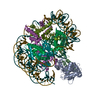
|
|---|---|
| 1 |
|
- Components
Components
-Protein , 6 types, 10 molecules ABNnOoPpQq
| #1: Protein | Mass: 28974.465 Da / Num. of mol.: 1 / Mutation: UbcH5c C85K Source method: isolated from a genetically manipulated source Source: (gene. exp.)  Homo sapiens (human) / Gene: BRCA1, UBE2D3, UBC5C, UBCH5C / Production host: Homo sapiens (human) / Gene: BRCA1, UBE2D3, UBC5C, UBCH5C / Production host:  References: UniProt: A0A386IN42, UniProt: P61077, UniProt: P38398*PLUS, E2 ubiquitin-conjugating enzyme, (E3-independent) E2 ubiquitin-conjugating enzyme, RING-type E3 ubiquitin transferase | ||||||
|---|---|---|---|---|---|---|---|
| #2: Protein | Mass: 12983.018 Da / Num. of mol.: 1 Source method: isolated from a genetically manipulated source Source: (gene. exp.)  Homo sapiens (human) / Gene: BARD1 / Production host: Homo sapiens (human) / Gene: BARD1 / Production host:  References: UniProt: Q99728, RING-type E3 ubiquitin transferase | ||||||
| #3: Protein | Mass: 14310.728 Da / Num. of mol.: 2 Source method: isolated from a genetically manipulated source Source: (gene. exp.)  Homo sapiens (human) Homo sapiens (human)Gene: H2AC18, H2AFO, HIST2H2AA, HIST2H2AA3, H2AC19, HIST2H2AA4 Production host:  #4: Protein | Mass: 13790.018 Da / Num. of mol.: 2 Source method: isolated from a genetically manipulated source Source: (gene. exp.)  Homo sapiens (human) / Gene: H2BC12, H2BFT, HIRIP1, HIST1H2BK / Production host: Homo sapiens (human) / Gene: H2BC12, H2BFT, HIRIP1, HIST1H2BK / Production host:  #5: Protein | Mass: 15257.838 Da / Num. of mol.: 2 / Mutation: C110A Source method: isolated from a genetically manipulated source Source: (gene. exp.)  Homo sapiens (human) Homo sapiens (human)Gene: H3C15, HIST2H3A, H3C14, H3F2, H3FM, HIST2H3C, H3C13, HIST2H3D Production host:  #6: Protein | Mass: 11263.231 Da / Num. of mol.: 2 Source method: isolated from a genetically manipulated source Source: (gene. exp.)  Homo sapiens (human) Homo sapiens (human)Gene: H4C1, H4/A, H4FA, HIST1H4A, H4C2, H4/I, H4FI, HIST1H4B, H4C3, H4/G, H4FG, HIST1H4C, H4C4, H4/B, H4FB, HIST1H4D, H4C5, H4/J, H4FJ, HIST1H4E, H4C6, H4/C, H4FC, HIST1H4F, H4C8, H4/H, H4FH, ...Gene: H4C1, H4/A, H4FA, HIST1H4A, H4C2, H4/I, H4FI, HIST1H4B, H4C3, H4/G, H4FG, HIST1H4C, H4C4, H4/B, H4FB, HIST1H4D, H4C5, H4/J, H4FJ, HIST1H4E, H4C6, H4/C, H4FC, HIST1H4F, H4C8, H4/H, H4FH, HIST1H4H, H4C9, H4/M, H4FM, HIST1H4I, H4C11, H4/E, H4FE, HIST1H4J, H4C12, H4/D, H4FD, HIST1H4K, H4C13, H4/K, H4FK, HIST1H4L, H4C14, H4/N, H4F2, H4FN, HIST2H4, HIST2H4A, H4C15, H4/O, H4FO, HIST2H4B, H4-16, HIST4H4 Production host:  |
-Widom 601 153- ... , 2 types, 2 molecules XY
| #7: DNA chain | Mass: 47457.234 Da / Num. of mol.: 1 Source method: isolated from a genetically manipulated source Source: (gene. exp.) synthetic construct (others) / Production host:  |
|---|---|
| #8: DNA chain | Mass: 46998.945 Da / Num. of mol.: 1 Source method: isolated from a genetically manipulated source Source: (gene. exp.) synthetic construct (others) / Production host:  |
-Non-polymers , 1 types, 4 molecules 
| #9: Chemical | ChemComp-ZN / |
|---|
-Details
| Has ligand of interest | N |
|---|
-Experimental details
-Experiment
| Experiment | Method: ELECTRON MICROSCOPY |
|---|---|
| EM experiment | Aggregation state: PARTICLE / 3D reconstruction method: single particle reconstruction |
- Sample preparation
Sample preparation
| Component |
| ||||||||||||||||||||||||
|---|---|---|---|---|---|---|---|---|---|---|---|---|---|---|---|---|---|---|---|---|---|---|---|---|---|
| Molecular weight |
| ||||||||||||||||||||||||
| Source (natural) |
| ||||||||||||||||||||||||
| Source (recombinant) |
| ||||||||||||||||||||||||
| Buffer solution | pH: 7.5 | ||||||||||||||||||||||||
| Buffer component |
| ||||||||||||||||||||||||
| Specimen | Conc.: 0.6 mg/ml / Embedding applied: NO / Shadowing applied: NO / Staining applied: NO / Vitrification applied: YES | ||||||||||||||||||||||||
| Specimen support | Grid material: COPPER / Grid mesh size: 400 divisions/in. / Grid type: C-flat | ||||||||||||||||||||||||
| Vitrification | Instrument: FEI VITROBOT MARK IV / Cryogen name: ETHANE / Humidity: 100 % / Chamber temperature: 298 K |
- Electron microscopy imaging
Electron microscopy imaging
| Experimental equipment |  Model: Titan Krios / Image courtesy: FEI Company |
|---|---|
| Microscopy | Model: FEI TITAN KRIOS |
| Electron gun | Electron source:  FIELD EMISSION GUN / Accelerating voltage: 300 kV / Illumination mode: FLOOD BEAM FIELD EMISSION GUN / Accelerating voltage: 300 kV / Illumination mode: FLOOD BEAM |
| Electron lens | Mode: BRIGHT FIELD / Nominal magnification: 130000 X / Nominal defocus max: 2700 nm / Nominal defocus min: 700 nm / Cs: 2.7 mm |
| Specimen holder | Specimen holder model: FEI TITAN KRIOS AUTOGRID HOLDER |
| Image recording | Average exposure time: 10 sec. / Electron dose: 90 e/Å2 / Detector mode: SUPER-RESOLUTION / Film or detector model: GATAN K2 SUMMIT (4k x 4k) / Num. of grids imaged: 2 |
| Image scans | Movie frames/image: 50 / Used frames/image: 1-50 |
- Processing
Processing
| EM software |
| ||||||||||||||||||||||||||||||||||||||||
|---|---|---|---|---|---|---|---|---|---|---|---|---|---|---|---|---|---|---|---|---|---|---|---|---|---|---|---|---|---|---|---|---|---|---|---|---|---|---|---|---|---|
| CTF correction | Type: PHASE FLIPPING AND AMPLITUDE CORRECTION | ||||||||||||||||||||||||||||||||||||||||
| Symmetry | Point symmetry: C1 (asymmetric) | ||||||||||||||||||||||||||||||||||||||||
| 3D reconstruction | Resolution: 3.9 Å / Resolution method: FSC 0.143 CUT-OFF / Num. of particles: 21479 / Symmetry type: POINT |
 Movie
Movie Controller
Controller



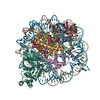

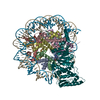
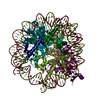
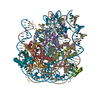
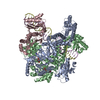
 PDBj
PDBj



















































